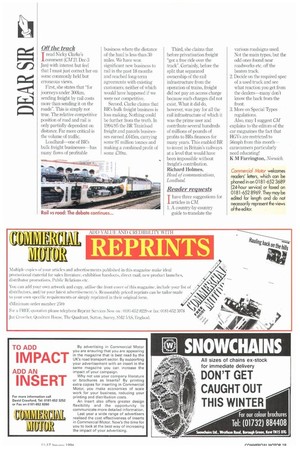Off the track
Page 21

If you've noticed an error in this article please click here to report it so we can fix it.
T read Nicky Clarke's lcomment (CM 21 Dec-3 Jan) with interest but feel that I must just correct her on some commonly held but erroneous views.
First, she states that "for journeys under 300Iun, sending freight by rail costs more than sending it on the roads". This is simply not true. The relative competitive position of road and rail is only partially dependent on distance. Far more critical is the volume of traffic.
Loadhaul—one of BR's bulk freight businesses—has many flows of profitable business where the distance of the haul is less than 30 miles. We have won significant new business to rail in the past 18 months and reached long-term agreements with existing customers, neither of which would have happened if we were not competitive.
Second, Clarke claims that BR's bulk freight business is loss making. Nothing could be further from the truth. In 1994/95 the BR Trainload freight and parcels businesses earned £645m, carrying some 97 million tonnes and making a combined profit of some L59m. Third, she claims that before privatisation freight "got a free ride over the track". Certainly, before the split that separated ownership of the rail infrastructure from the operation of trains, freight did not pay an access charge because such charges did not exist. What it did do, however, was pay for all the rail infrastructure of which it was the prime user and contribute several hundreds of millions of pounds of profits to BRs finances for many years. This enabled BR to invest in Britain's railways at a level that would have been impossible without freight's contribution. Richard Holmes, Head of communications, Load/mu!.
Reader reauests
T have three suggestions for larticles. in CM.
1. A country-by-country guide to translate the various roadsigns used. Not the main types, but the odd ones found near roadworks etc. off the beaten track.
2. Decide on the required spec of a used truck and see what reaction you get from the dealers—many don't know the back from the front.
3. More on Special Types regulations.
Also, may I suggest CM explains to the editors of the car magazines the fact that FIGVs are restricted to 56mph from this month caravanners particularly need educating!
K M Farrington, Norwich.
Commercial Motor welcomes readers' letters, which can be phoned in on 0181-652 3689 (24-hour service) or faxed on 0181-652 8969. They may be edited for length and do not necessarily represent the views of the editor.












































































































